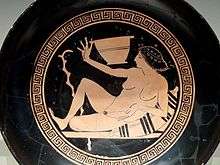Hetaira
Hetaira /hɪˈtaɪrə/ (plural hetairai (/hɪˈtaɪraɪ/), also hetaera /hɪˈtɪrə/ (plural hetaerae /hɪˈtɪriː/), (Ancient Greek: ἑταίρα, "companion", pl. ἑταῖραι, Latin: hetaera, pl. hetaerae) was a type of prostitute in ancient Greece.
_-_01.jpg)
Traditionally, historians of ancient Greece have distinguished between hetairai and pornai, another class of prostitute in ancient Greece. In contrast to pornai, who provided sex for numerous clients in brothels or on the street, hetairai were thought to have had only a few men as clients at any one time, to have had long-term relationships with them, and to have provided companionship and intellectual stimulation as well as sex.[1] For instance, Charles Seltman wrote in 1953 that "hetaeras were certainly in a very different class, often highly educated women".[2]
More recently, however, historians have questioned the extent to which there was really a distinction between hetairai and pornai. The second edition of the Oxford Classical Dictionary, for instance, held that hetaira was a euphemism for any kind of prostitute.[3] This position is supported by Konstantinos Kapparis, who holds that Apollodorus' famous tripartite division of the types of women in the speech Against Neaera ("We have courtesans for pleasure, concubines for the daily tending of the body, and wives in order to beget legitimate children and have a trustworthy guardian of what is at home."[4]) classes all prostitutes together, under the term hetairai.[5][6]
A third position, advanced by Rebecca Futo Kennedy, suggests that hetairai "were not prostitutes or even courtesans".[7] Instead, she argues, hetairai were "elite women ... who participated in sympotic and luxury culture",[8] just as hetairoi – the masculine form of the word – was used to refer to groups of elite men at symposia.[7]
Even when the term hetaira was used to refer to a specific class of prostitute, though, scholars disagree on what precisely the line of demarcation was. Kurke emphasises that hetairai veiled the fact that they were selling sex through the language of gift-exchange, while pornai explicitly commodified sex.[9] She claims that both hetairai and pornai could be slaves or free, and might or might not work for a pimp.[9] Kapparis says that hetairai were high-class prostitutes, and cites Dover as pointing to the long-term nature of hetairai's relationships with individual men.[10] Miner disagrees with Kurke, claiming that hetairai were always free, not slaves.[11]

Along with sexual services, women described as hetairai rather than pornai seem to have often been educated, and have provided companionship.[12] According to Kurke, the concept of hetairism was a product of the symposium, where hetairai were permitted as sexually available companions of the male party-goers.[13] In Athenaeus' Deipnosophistai, hetairai are described as providing "flattering and skillful conversation": something which is, elsewhere in classical literature, seen as a significant part of the hetaira's role.[14] Particularly, "witty" and "refined" (αστεία) were seen as attributes which distinguished hetairai from common pornai.[15] Hetairai are likely to have been musically educated, too.[16]
Free hetairai could become very wealthy, and control their own finances. However, their careers could be short, and if they did not earn enough to support themselves, they might have been forced to resort to working in brothels, or working as pimps, in order to ensure a continued income as they got older.[17]
See also
References
- Kurke, Leslie (1997). "Inventing the "Hetaira": Sex, Politics, and Discursive Conflict in Archaic Greece". Classical Antiquity. 16 (1): 107–108.
- Seltman, Charles (1953). Women in Greek Society. London. p. 115ff., quoted in Davidson 1997, p. 75
- Hammond, N.G.L.; Scullard, H.H., eds. (1970). The Oxford Classical Dictionary (2 ed.). Oxford: Oxford University Press. p. 512.
- Kapparis, Konstantinos A. (1999). Apollodoros 'Against Neaira' [D.59]. p. 161.
- Kapparis, Konstantinos A. (1999). Apollodoros 'Against Neaira' [D.59]. p. 5.
- Kapparis, Konstantinos A. (1999). Apollodoros 'Against Neaira' [D.59]. pp. 422–423.
- Futo Kennedy, Rebecca (2014). Immigrant Women in Athens: Gender, Ethnicity, and Citizenship in the Classical City. New York: Routledge. p. 69. ISBN 9781138201033.
- Futo Kennedy, Rebecca (2014). Immigrant Women in Athens: Gender, Ethnicity, and Citizenship in the Classical City. New York: Routledge. p. 74. ISBN 9781138201033.
- Kurke, Leslie (1997). "Inventing the "Hetaira": Sex, Politics, and Discursive Conflict in Archaic Greece". Classical Antiquity. 16 (1): 108.
- Kapparis, Konstantinos A. (1999). Apollodoros 'Against Neaira' [D.59]. p. 408.
- Miner, Jess (2003). "Courtesan, Concubine, Whore: Apollodorus' Deliberate Use of Terms for Prostitutes" (PDF). The American Journal of Philology. 124 (1): 23.
- Kapparis, Konstantinos A. (1999). Apollodoros 'Against Neaira' [D.59]. p. 6.
- Kurke, Leslie (1997). "Inventing the "Hetaira": Sex, Politics, and Discursive Conflict in Archaic Greece". Classical Antiquity. 16 (1): 115.
- McClure, Laura (2003). "Subversive Laughter: The Sayings of Courtesans in Book 13 of Athenaeus' Deipnosophistae". The American Journal of Philology. 124 (2): 265.
- McClure, Laura (2003). "Subversive Laughter: The Sayings of Courtesans in Book 13 of Athenaeus' Deipnosophistae". The American Journal of Philology. 124 (2): 268.
- Hamel, Debra (2003). Trying Neaira: The True Story of a Courtesan's Scandalous Life in Ancient Greece. New Haven & London: Yale University Press. p. 12.
- Kapparis, Konstantinos A. (1999). Apollodoros 'Against Neaira' [D.59]. p. 7.
Further reading
- Davidson, J. (1998). Courtesans and Fishcakes: The consuming passions of classical Athens. London: Fontana.
- An essay on women’s lives in classical Athens
- The hetaerae of Athens - from Book 13 of Athenaeus
| Wikimedia Commons has media related to Hetaeras. |